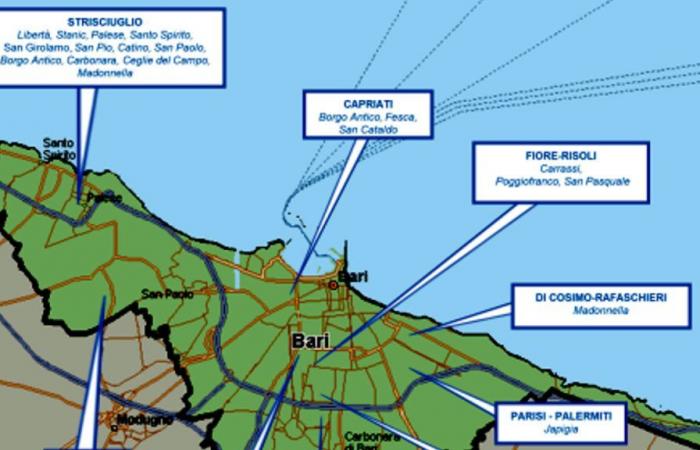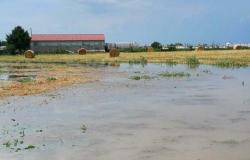Drug trafficking and dealing as the “main interest”, but also extortion, usury, illicit betting, and an increasingly high capacity to infiltrate the economic fabric, and beyond. The report periodically released by the Dia (Anti-Mafia Investigation Directorate) ‘photographs’ business, presence in the area and evolutionary dynamics of Bari crime. The latest dossier, released today, refers to the first half of 2023.
The Bari Camorra: business and infiltration capacity
“In a continuously evolving mafia scenario, strongly characterized by continuous internal fibrillations or between opposing criminal groups – we read in the Report – the Bari Camorra is characterized by a plurality of clans which, as in the Neapolitan Camorra model, does not provide for top management appointments with coordination functions but horizontal relationships. This allows them to operate in complete autonomy although, where divergent interests exist, there are violent conflicts aimed at asserting the supremacy of a specific association”. As regards, as mentioned, the illicit activities of the clans, even in the semester examined, “drug trafficking confirms itself as the main interest of the gangs of the capital of Bari which in many cases, with a view to controlling the territory, directly manage even up to drug dealing activities”. “In the criminal dynamics of Bari there is no shortage of episodes of abuse through the use of intimidation and violence used by the clans to express their power of subjugation on the territory”. But Bari crime, “also dedicated to smuggling, extortion, usury and illicit betting”, also demonstrates an increasingly higher power of infiltration “into the healthy economic fabric”, “through increasingly complex forms of money laundering”, ” also making use of compliant professionals and sometimes infiltrating the local institutional apparatus”. At the same time, the Dia highlights, “among the most incisive and significant results of the constant pressure of counteraction by the institutions”, “the increase in the number of justice collaborators, a phenomenon which mainly concerned the Bari teams” .
The map of crime in Bari: the four hegemonic clans
As regards the presence of criminal groups in the territory of the metropolitan city, the Dia identifies four “hegemonic” clans, largely “corresponding to as many mafia families historically rooted in the Apulian capital, with ramifications in the province and projections also in different areas of the Region “. These are the Capriati, the Strisciuglio, the Parisi-Palermiti, and the Diomede-Mercante. As regards the Di Cosola clan, “weakened by the death of its top member as well as by the anti-government activity of the institutions”, the Dia notes that the comrades, despite experiencing “a moment of strong internal friction”, “would nevertheless show signs of possible attempts at reconstitution and reaffirmation”. The four clans considered hegemonic in the territory are “subordinated – highlights the Report – by a plurality of smaller groups, with limited operational autonomy and, among these, include the Misceo, Montani, Anemolo, Fiore-Risoli, Di Cosimo groups -Rafaschieri, Lorusso, Velluto and Telegraph”.
The Capriati, the opposition to the Strisciuglio and the relations with the Parisi-Palermiti
Among the four hegemons, the Capriati clan emerges, historically active in the ancient village of Bari “as well as, through its representatives, in the Fesca neighborhoods and in the San Cataldo area and in a vast portion of the province of Bari and in some centers of the BAT province” . The association, the Dia’s half-yearly report always notes, “is mainly dedicated to drug trafficking, extortion and the management of gambling. Given the prolonged state of detention of the historic head of the clan, several regents have joined forces over time , including the last one, murdered on 21 November 2018”. Recent news, not the subject of the current Dia report, also includes the murder of Lello Capriati, killed shortly after his release from prison, and considered another prominent member of the clan. In June 2023, the Carabinieri of Bari arrested two subjects held responsible for a murder committed on 29 September 2021 in the San Girolamo district of Bari. An investigation which, highlights the Dia, “documented the interconnected criminal dynamics underlying the now full-blown and more current than ever is the friction between the Strisciuglio clan on the one hand, with particular reference to the structure of the San Paolo neighborhood of Bari and the Parisi-Palermiti and Capriati clans on the other, generated due to the need for control of the territory and exacerbated by criminal politics expansionist implemented by the Strisciuglio group, at the same time confirming the good relations existing between the Japigia clan and the Capriati”.
The ‘moon’ clan: the Strisciciuglio
The Strisciuglio clan is indicated by Dia as the “largest and most aggressive” organization among the Bari clans. Considered to be operating “in the Borgo Antico of Bari as well as, through its branches, in the Libertà, Stanic, San Paolo, San Girolamo, Palese, Santo Spirito, San Pio – Catino, Carbonara, Ceglie del Campo and Madonnella districts”, the group is active “in drug trafficking, extortion, usury, recycling and distribution of gaming/entertainment equipment. The clan, which is based on the classic rites of mafia affiliation, is divided into interacting groups respecting the different territories of influence and autonomy of each one, with its own top exponents, middle managers, criminal labourers, soldiers and fire groups. The organization in question can be considered”. During the period covered by the report, “the predatory attitude of the clan emerged more relevant than ever and, with violence and intimidating force, continues to harass entrepreneurs and traders from Bari”. Among the main operations carried out in 2023, one relating to the month of February and one in April of the same year.
The Parisi-Palermiti clan
Historically rooted in the Japigia district of Bari, but “on the rise throughout the province”. Regarding the Parisi clan, Dia notes the role of the historic clan leader Savino, considered, despite his long detention, “capable of carrying out functions of guarantor of the criminal balance between the various Bari gangs”. The group is considered active in extortion, usury, drug trafficking, hydrocarbon smuggling and gambling. “The clan, which remains characterized by a pyramid-type organisation, is structured around a series of autonomous groups or even individual representatives who operate in synergy with each other, not without episodes of conflict, in the management of criminal activities in their respective territories (areas of capital, San Pasquale, Carrassi and Poggiofranco districts or hinterland centres)”. In March 2023, eleven people were convicted in first degree for the murder of Rafaschieri and the attempted murder of his brother which occurred in 2018, “with the aggravating circumstance of the mafia method except for one of them, since he would have acted without the awareness of helping the Palermiti clan”.
The Diomede-Merchant clan
The Diodeme-Mercante clan, “federated to the powerful Capriato clan, is made up – highlights the Dia – of two families: the Diomede whose areas of influence, especially with regards to drug dealing, are the Poggiofranco, Picone, Carrassi and San Pasquale, although in these areas there is no shortage of opportunities for friction with other clans; the Mercante, a family very close to the Capriati, active above all in the Libertà district, with ramifications on the San Paolo district, where criminal dominance is contested with other rival clans”.






